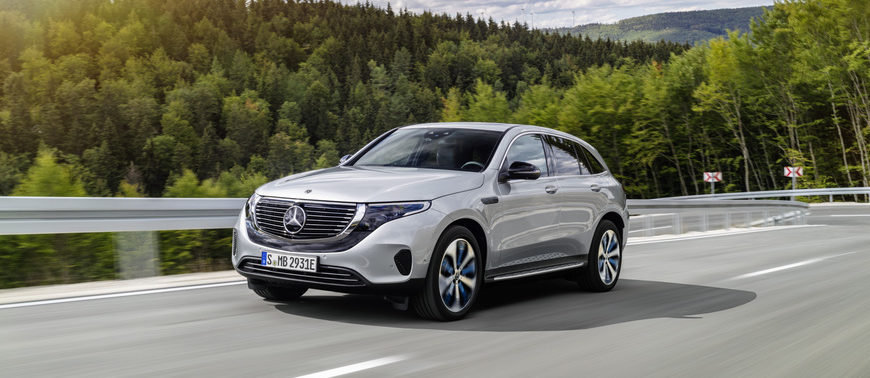
The Art of the Sub-Brand: Eco-Friendly
Eco sub-brands may be the new competitive battlefield
By Randy Lioz, Editor, Car-ED.com | September 2018
When Toyota built the Prius into an entire sub-brand unto itself, it cast a green glow over the mothership. Now others are trying similar, yet distinctive, strategies in the alternative powertrain market. They range from creating different variants of a single model to planning the build-out of entire lineups. Here we’ll take a look at what’s out there right now and how things may develop in the future.
Where did the trend start?
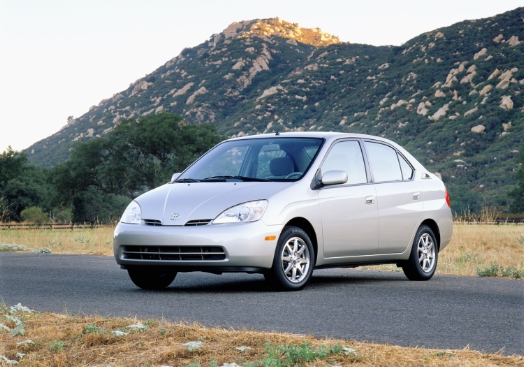
1st-generation Prius
The Honda Insight may have beaten the Toyota Prius to the punch, as the first hybrid vehicle introduced in the United States, by seven months. But the Prius, particularly in its second incarnation, went on to become not just the most successful electrified vehicle in history, but one of the most successful single models of any type, selling over four million copies so far.
Toyota realized the gold it had on its hands, not just as a financial success, but as a green halo for the entire brand. So it took the Prius nameplate and expanded it to a larger lineup, from the compact Prius c hatch to the Prius V tall wagon. It has since renamed its plug-in model the Prius Prime, seeking to further differentiate it from the plug-less hybrid, but still banking on the Prius name.
What are others doing?
While the industry has tried gamely to replicate Toyota’s success, no one has even come close. In December of 2010 both Nissan and Chevrolet introduced the cars they hoped would set the mold for the future of transportation. Despite big marketing pushes, the Nissan Leaf full electric car and the Chevy Volt plug-in hybrid each managed to sell just a small fraction of the Priuses that Toyota had sold in its peak years. Plug-in EVs were proving to be a tougher nut to crack, with even Toyota managing to sell or lease only around 4,000 copies of its two generations of RAV4 EV (at its peak it was selling over 200,000 Prius-badged vehicles a year).
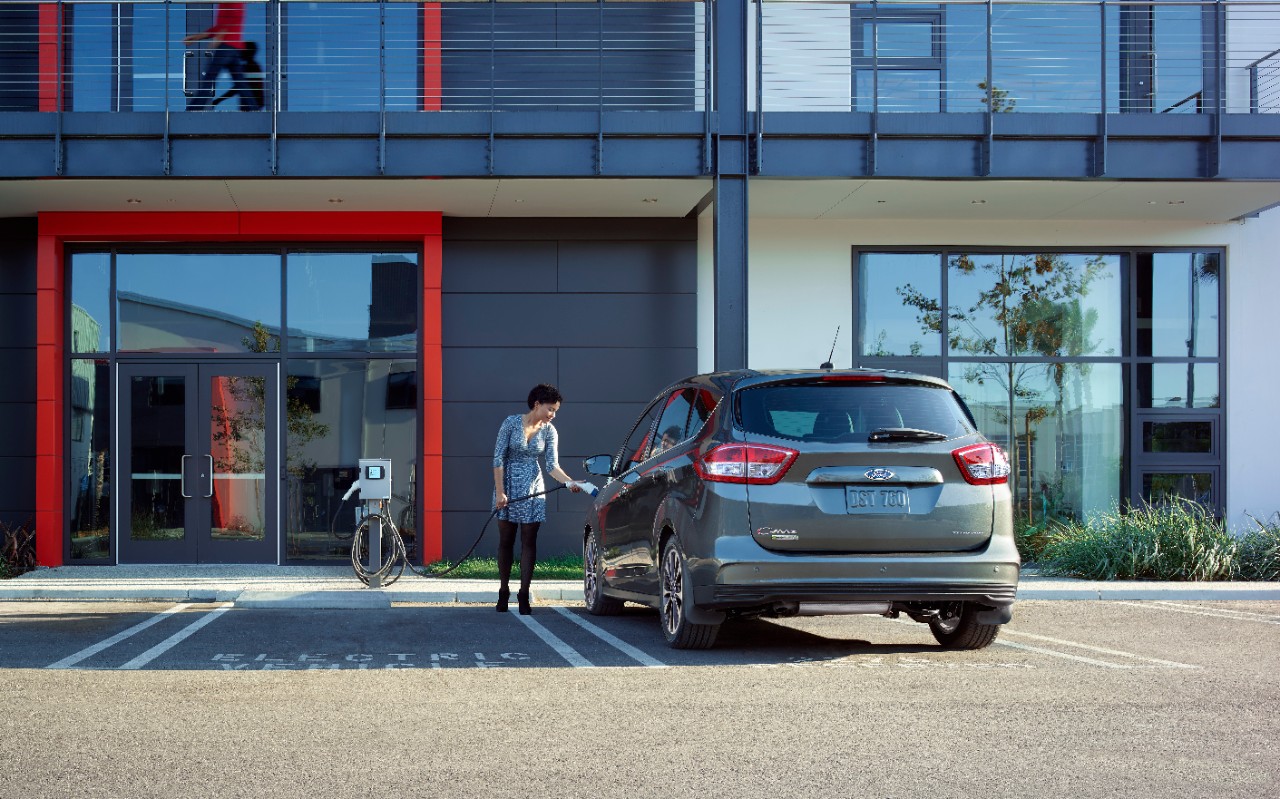
Ford C-Max Energi
Ford has taken a more conservative approach, focusing on offering electrified versions of existing models, but in the process the company has offered a glimpse into the future of the EV market. Its Energi label is attached to Ford’s plug-in hybrids, making it the first example of a name that was intended from the start to act as an EV sub-brand across models. Still, the Energi lineup has been limited so far, with only the C-Max and Fusion getting versions, the former having been discontinued.
As Ford shifts its attention to SUVs, the next models to get the Energi treatment may be the Escape compact and the full-sized Expedition. But the tag has not been used for a fully electric model, such as the Focus Electric. And Ford’s upcoming dedicated electric model may just be called the Model E.
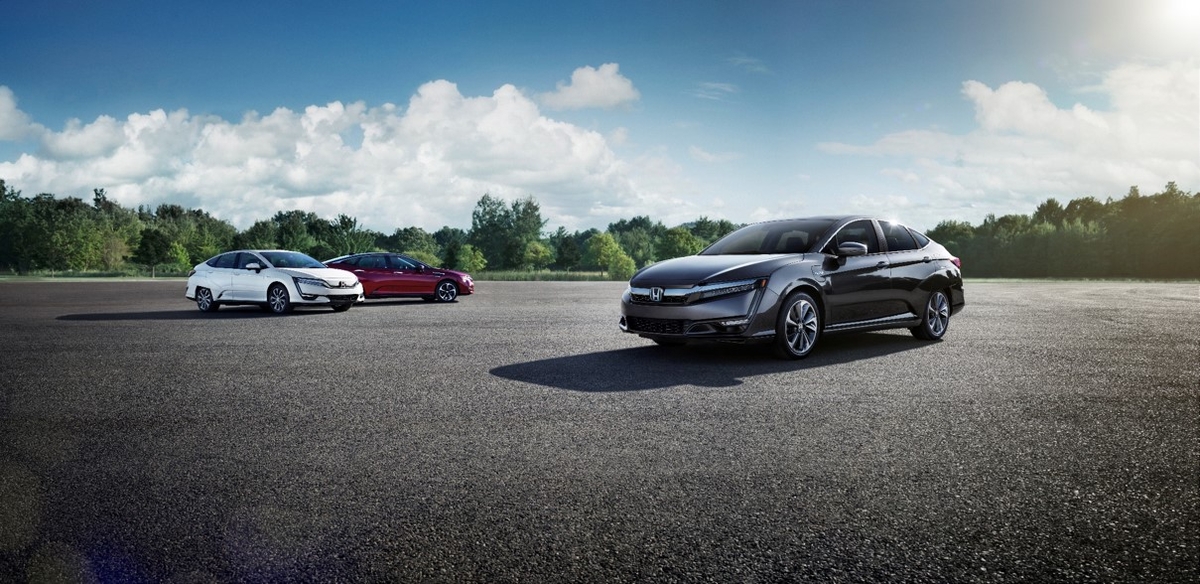
Honda Clarity Series
That car is likely to reflect a trend that’s becoming more common in the industry: dedicated alt-fuel models that have various versions to appeal to the widest possible audience. The Model E may have both plug-in hybrid (PHEV) and battery-electric vehicle (BEV) variants. Brands like Honda, Hyundai and Kia are taking a similar approach. The Honda Clarity comes in PHEV, BEV and fuel-cell electric (FCEV) models. The Hyundai Ioniq offers a non-plug-in hybrid (HEV), a PHEV and a BEV, and—since Hyundai and Kia have the same parent company—so too will the Kia Niro, whose BEV version will launch soon.
These multi-version models may get close to the idea of an environmentally-friendly sub-brand, but it’s the German companies that are moving most aggressively toward this future.
What’s the German approach?
BMW i
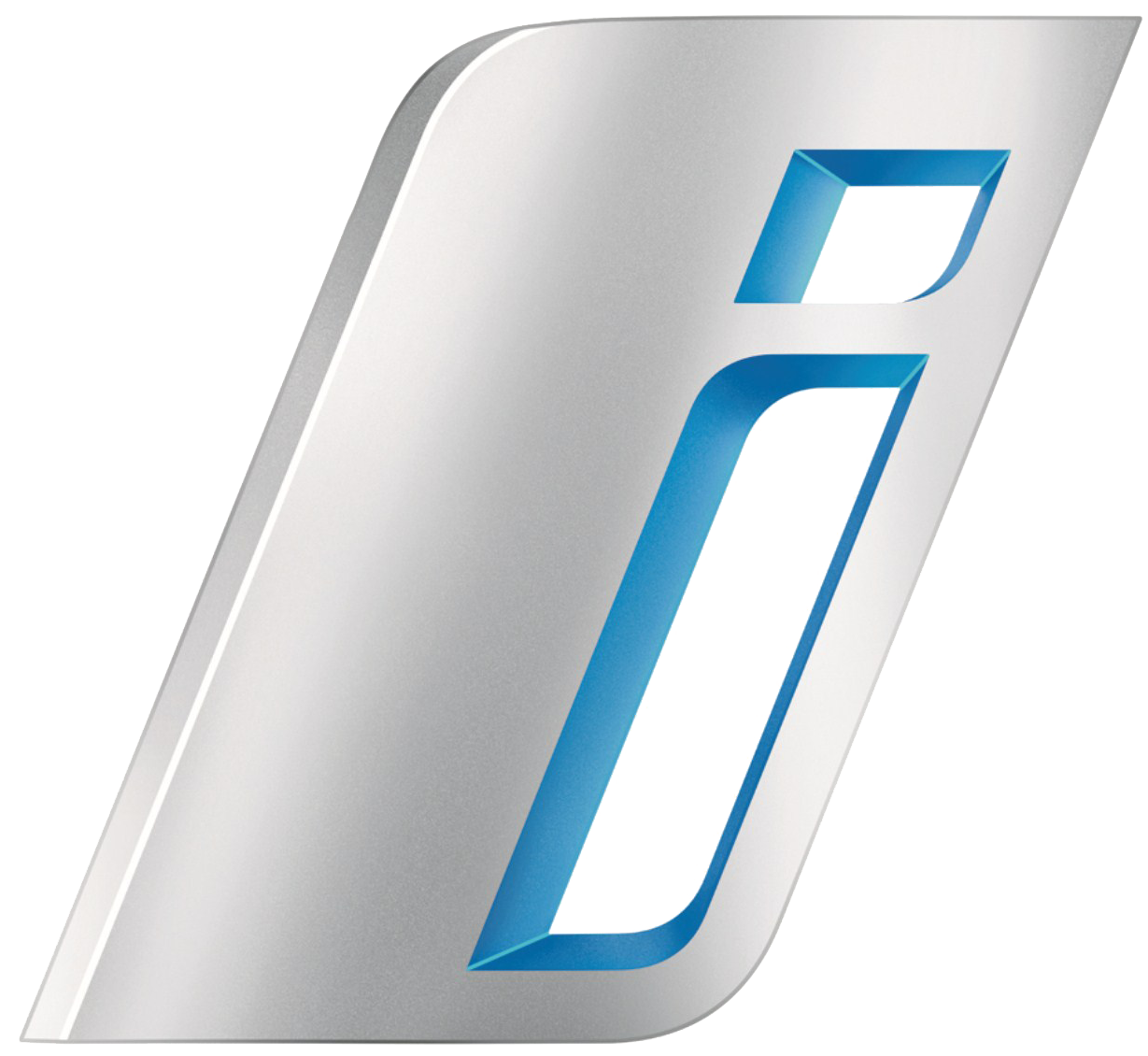 It was BMW that first moved towards the idea of building a brand entirely around the idea of electrification. The Bavarian brand has been a pioneer in the art of the automotive sub-brand, building its M (Motorsport) badge into one of the most revered performance brands in the industry. With European governments and automakers increasingly embracing electrification, BMW decided back in 2011 to introduce a new brand called “i” that would include a line of specialized electrified vehicles. BMW i would appeal to a different customer from the normal buyer of “The Ultimate Driving Machine,” so they’re set apart from the internal combustion models in BMW dealerships.
It was BMW that first moved towards the idea of building a brand entirely around the idea of electrification. The Bavarian brand has been a pioneer in the art of the automotive sub-brand, building its M (Motorsport) badge into one of the most revered performance brands in the industry. With European governments and automakers increasingly embracing electrification, BMW decided back in 2011 to introduce a new brand called “i” that would include a line of specialized electrified vehicles. BMW i would appeal to a different customer from the normal buyer of “The Ultimate Driving Machine,” so they’re set apart from the internal combustion models in BMW dealerships.
And the brand is more than just cars. It’s structured to enable different mobility business models, based on technology like autonomous driving that will be baked into its models in the coming years. But you’re here at Car-ED to learn about the cars, so let’s get into what makes them unique.
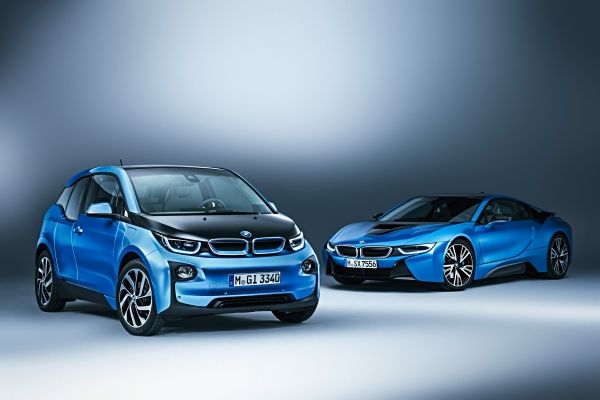
BMW i3 and i8
The first two models that BMW introduced under this brand are the i3 and i8. While they may look very different, they share some details that distinguish them from more conventional vehicles, like their platform construction that was specifically designed for electric motors, and their heavy reliance on lightweight materials, like aluminum and carbon fiber reinforced plastics. Both are available as plug-in hybrids, but the i3 can also be had as a pure EV, without its “range extender” internal combustion engine.
The i8 is really a halo car, with scissor-style doors and a starting price of nearly $150,000. The i3 gives EV buyers a much more accessible entree into the i sub-brand, with a starting price around $45,000, though its styling is quite polarizing, limiting its appeal among more conventional buyers. Still, the i3’s boxy profile allows for quite a spacious interior despite its small footprint, and the window cutouts on the rear-hinged rear doors—especially in combination with the lighter-colored natural materials chosen for some of the trims—help make even the rear seats seem airy. The i3 has also been lauded for its fun handling, belying its toaster-like stance.
BMW is just getting started with i, though the strategy has shifted somewhat, bringing a convergence of the company’s traditional and electric vehicle platforms. Future BMWs will all be based on an architecture that allows for electrification across the board, with plug-in versions of every model bearing the iPerformance badge. The plan also includes more extensive electrification of the MINI brand. All told BMW will have 25 plug-in or all-electric models in its lineup by 2025.
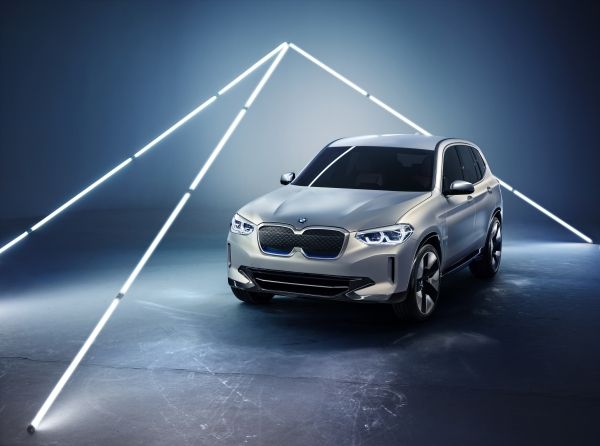
BMW iX3 Concept
The next BEV planned will be for the 2020 model year. With U.S. automotive demand shifted strongly towards crossovers, the holy grail seems to be a well-executed all-electric CUV, so the Bavarians are planning an electric version of the next-gen X3, possibly to be called the iX3. (BMW is planning such an extensive EV push that they’ve secured naming rights for all “i” vehicles, including i1 through i9 for cars, and iX1 through iX9 for crossovers.)

BMW iNEXT Teaser
The most exciting news from BMW i may be the iNEXT, which is coming in 2021 and is billed as the “technology flagship” of the whole company. It’ll be a crossover-ish vehicle, in similar ways to how many EVs have been blurring the car-crossover line lately, like the coupe-ish Tesla Model X and the wagon-esque Jaguar I-PACE. BMW previewed it with the Vision Next 100 Concept two years ago, and has been teasing it ever since, announcing a range of 435 miles—that’s 100 more than Tesla’s best—and dropping preview sketches. The iNEXT is also slated to get autonomous tech, perhaps even up to Level 4, which means that the vehicle can handle everything within certain environments.
VW I.D.
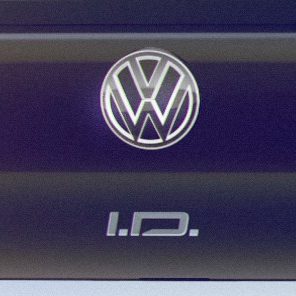
With Volkswagen squarely in the middle of the diesel scandal that broke a few years ago, the company responded with a profound shift in philosophy. While its previous moonshot vehicle was a diesel hybrid called the XL1, VW shifted its future focus to all-electric vehicles, hoping to help ween consumers off of internal combustion once and for all.
As such, the brand has introduced a series of concept cars intended to preview the brand’s new I.D. lineup of EVs. The onslaught kicked off in Paris in 2016 with the I.D. concept, built upon the company’s new all-electric vehicle architecture, dubbed “MEB.” This platform will underpin all of the BEVs the company will produce in the coming years. The I.D. will spawn an actual production car—scheduled for late next year—but one that’s only aimed at markets other than our own, meaning we’ll have to wait a bit longer for our first I.D. vehicle.
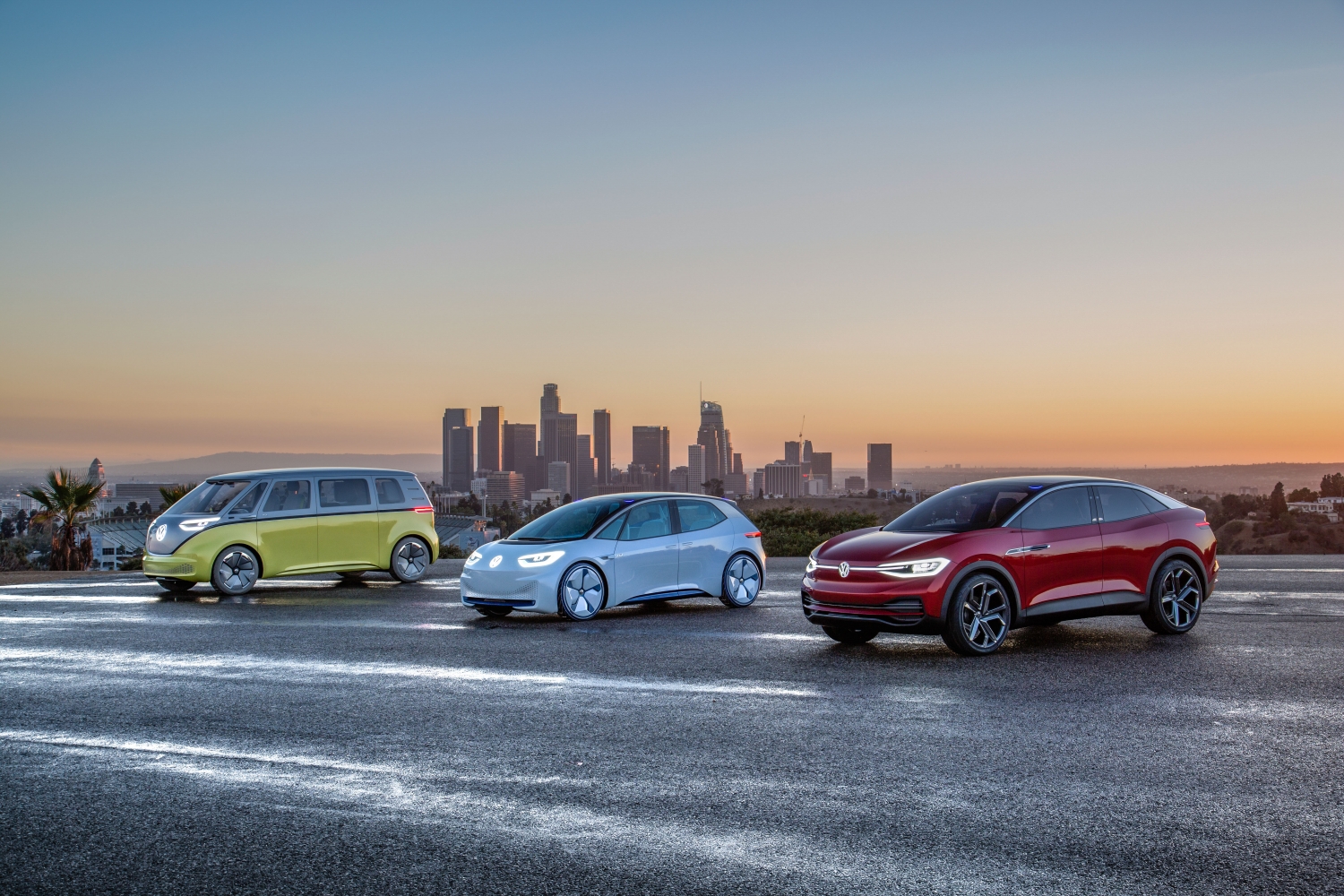
VW I.D. Buzz, I.D. and I.D. Crozz concepts
It will come for the 2021 model year, in the form of a compact crossover based on the I.D. Crozz concept from last year. Like the I.D. small hatch, this CUV will sport the I.D. brand’s styling cues, including a glowing VW badge between uniquely styled lights, and only a lower air dam for battery cooling. When it comes to the EV powertrain, remember the number 300, as in roughly 300 hp and 300 miles of range.
Also shared with the other I.D. vehicles will be the I.D. Pilot system, which promises to bring autonomous driving—including a retracting steering wheel—to the U.S. market by 2025. Because of the unique interior flexibility requirements of self-driving vehicles, VW has also created an “Open Space” design concept for the I.D. lineup, which uses adaptive lighting and surfaces to offer an environment that responds to the mode of the vehicle and how passengers might be using it differently.
Future I.D. models for the U.S. market should include a minivan-type vehicle that pays homage to the Type 2—aka Microbus—of the ’50s and ’60s, made popular by hippies and surfers. It was previewed by the I.D. Buzz at the Detroit auto show last year. Also coming is a sedan based off the I.D. Vizzion concept from this year’s Geneva show. Both of these vehicles are purportedly coming in 2022. The big news with the Vizzion concept was the intention that it be a fully self-driving vehicle, but with Level 5 autonomous unlikely to be realized by the time it hits the market, this will probably be further down the line.
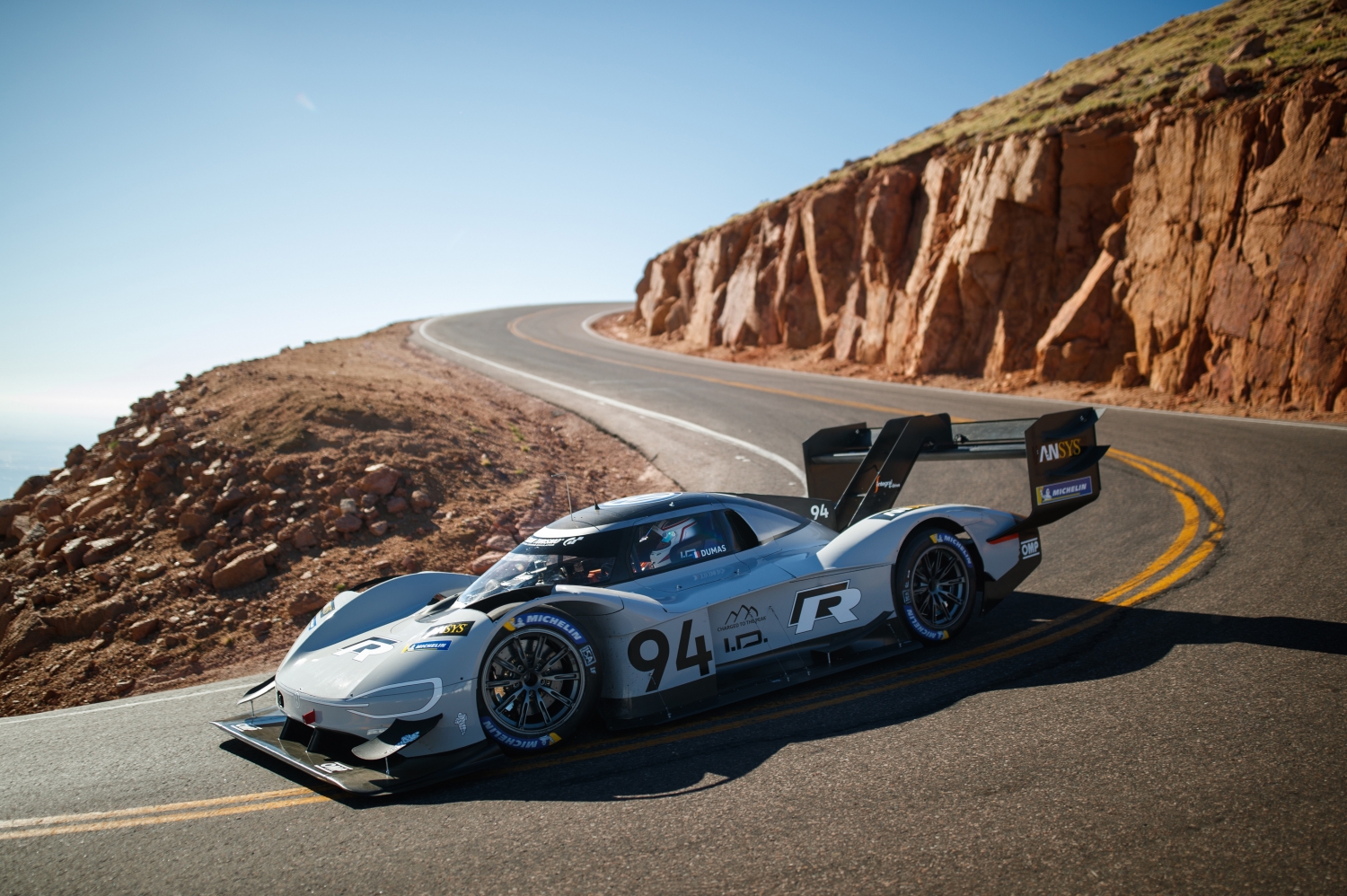
I.D. R tackling Pike’s Peak
One other car associated with the I.D. line is VW’s I.D. R race car, which earlier this year smashed the Pike’s Peak Hill Climb record, not only for an EV, but for any car in the course’s history, the first to break eight minutes.
Mercedes-Benz EQ
 The EQ electric vehicle line will be a multi-brand effort, with Daimler, Mercedes’ parent company, planning ten new EVs by 2022, including seven from Mercedes and three from the smart micro-car brand. Mercedes says EQ stands for Electric Intelligence, and you might say, but wait, they didn’t name it EI! It helps to understand that IQ, or “Intelligence Quotient,” helped give rise to the idea of emotional intelligence, which was dubbed EQ. The quotient part got dropped somewhere, but Mercedes is fine with that, and the moniker will be attached to every one of its electrified models going forward.
The EQ electric vehicle line will be a multi-brand effort, with Daimler, Mercedes’ parent company, planning ten new EVs by 2022, including seven from Mercedes and three from the smart micro-car brand. Mercedes says EQ stands for Electric Intelligence, and you might say, but wait, they didn’t name it EI! It helps to understand that IQ, or “Intelligence Quotient,” helped give rise to the idea of emotional intelligence, which was dubbed EQ. The quotient part got dropped somewhere, but Mercedes is fine with that, and the moniker will be attached to every one of its electrified models going forward.
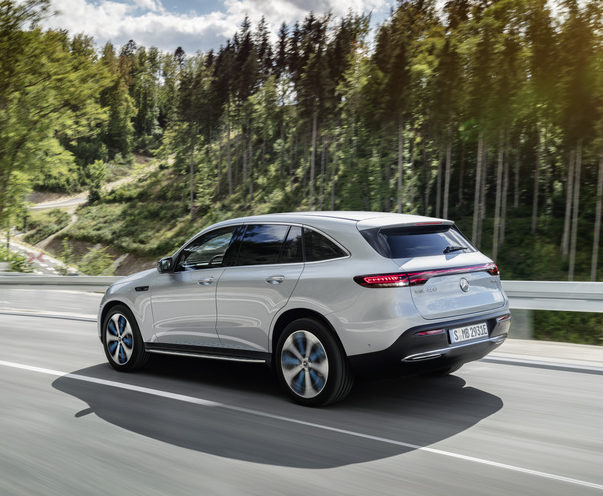
2019 Mercedes-Benz EQC
The first is the EQC, which joins a growing list of electric compact CUVs from luxury brands, which we first talked about in our write-up of the Jaguar I-PACE. Mercedes just unveiled the production version of the EQC, and it’ll start sales next year. It was rumored to have a range of 300+ miles, but Mercedes, after initially announcing a range of only 200 miles, has updated that to a much more competitive 279; the I-PACE has 240 miles of range. Mercedes has yet to announce a final range spec for the vehicle.
Like many companies Mercedes is using its electric sub-brand to launch its vision for the future of mobility. In the case of EQ, though, this includes trip-planning tools and an “EQ Community” with exclusive events, rather than vehicle sharing platforms, which the company is already doing with Car2Go.
Future EQ models will include an EQA small hatch and an EQS large luxury sedan, both planned for 2020. Mercedes will be rolling out an EQ Power badge for its plug-in hybrids as well, starting next year with the S560e Sedan, to ensure that buyers form a strong association with the EQ brand for electrification.
Are any other companies doing an EV sub-brand?
Aston Martin Lagonda
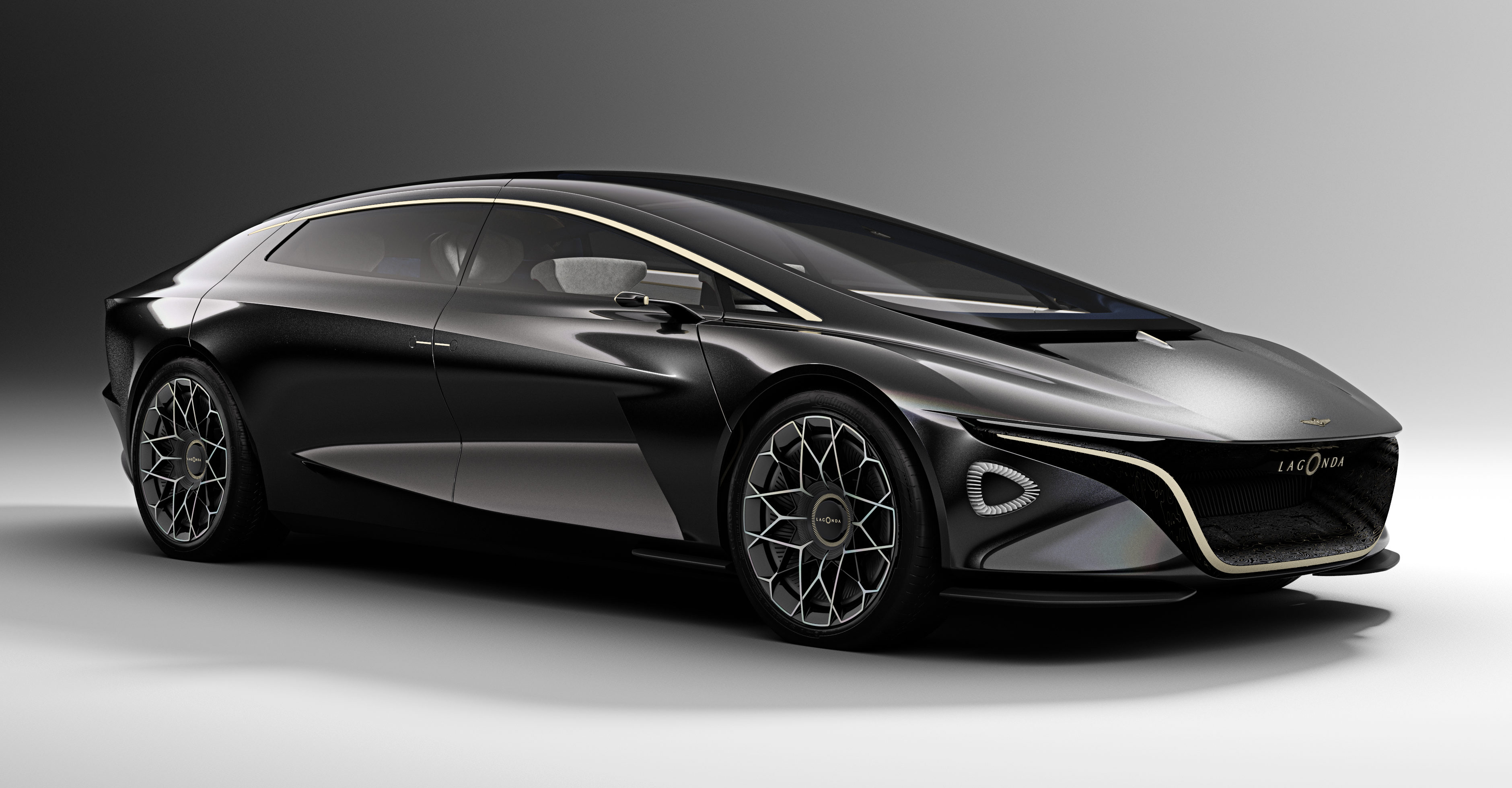
Lagonda Vision Concept
The Lagonda brand was acquired by Aston in 1947, and it’s re-emerged every so often, usually in the form of sedans to complement the brand’s sports-car-dominated lineup. Now Aston is re-imagining the future of Lagonda as a pure electric brand. Its first vehicle, a crossover utility, will be unveiled in 2021, so there’s not much detail around it yet, but it’ll take styling cues from the Vision Concept introduced in Geneva this year.
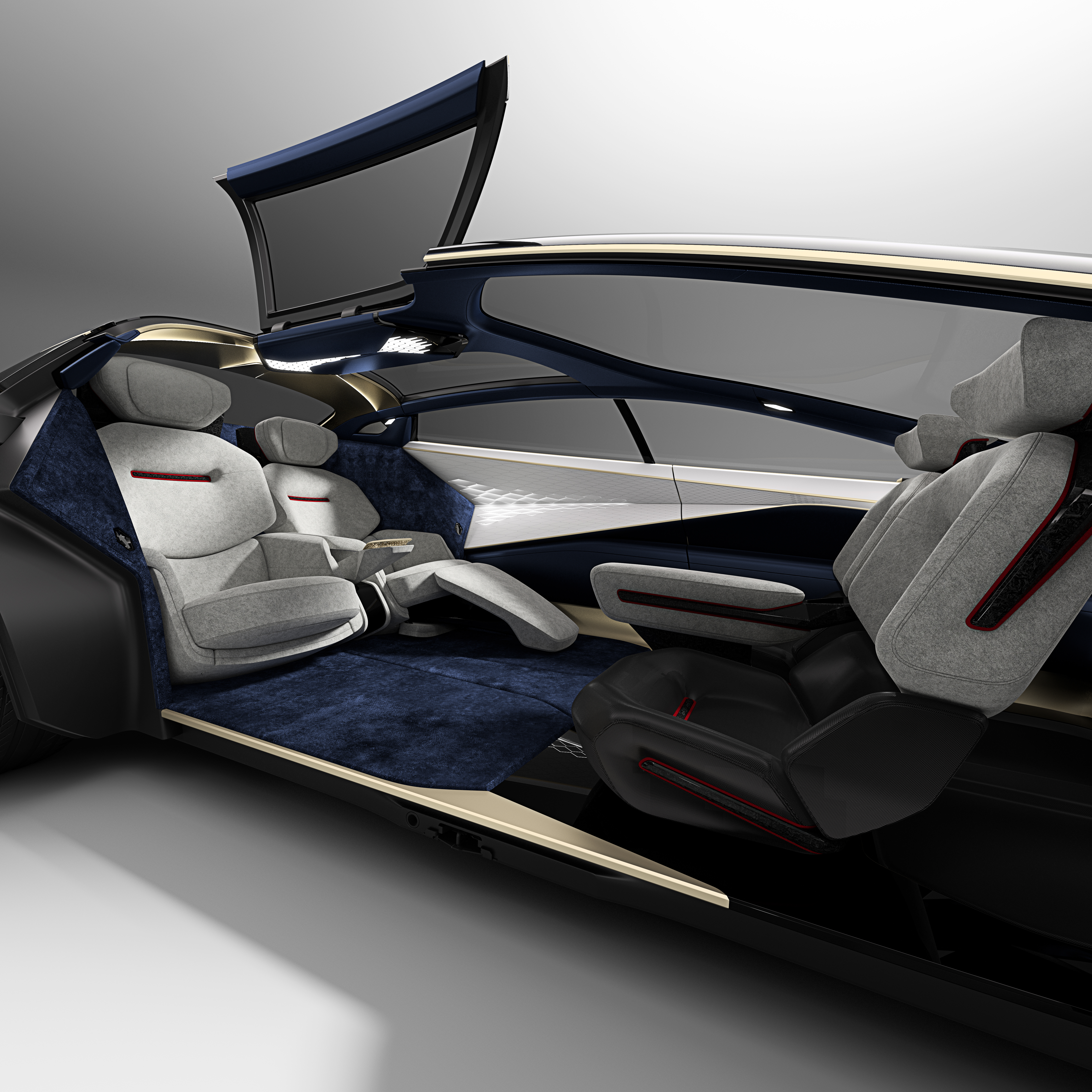
Lagonda Vision interior
One of the brand’s marquee features will be 800-volt charging, which will allow the car to replenish its battery juice much more quickly. This tech is first being rolled out in the RapidE luxury sedan, which isn’t branded with the Lagonda name, and is an electrified version of the Rapide sedan. It’ll be going to 155 lucky customers next year, but all copies are spoken for, so save your $207,775 if you’re not already on the list.
The bottom line…
While most companies in the industry have embraced the idea of electrification as the future of mobility, these few believe that it will be enough of a revolution to warrant completely new branding. It remains to be seen whether these sub-brands will find the same success that performance sub-brands did before them.
The chart below lays out the landscape of eco sub-brands, both present and future.
This article was updated to reflect new range information from Mercedes-Benz on the EQC.
Brand |
Eco Sub-Brand |
First Model |
Launch Year |
| Aston Martin | Lagonda | CUV | After 2021 |
| BMW | i | i3 & i8 | 2013 |
| Ford | Energi | C-Max Energi | 2012 |
| Honda | Clarity | FCX Clarity Fuel Cell EV | 2008 |
| Hyundai | Ioniq | Ioniq Hybrid | 2016 |
| Kia | Niro | Niro Hybrid | 2016 |
| Mercedes-Benz | EQ | EQC | 2019 |
| Toyota | Prius | Prius | 1997 |
| Volkswagen | I.D. | I.D. CUV | 2019 |